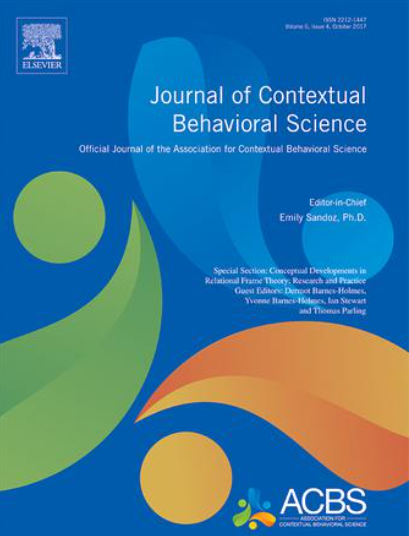结合ACT和ERP治疗强迫症:一项检查症状减轻和心理灵活性机制的随机对照试验
IF 3
3区 心理学
Q1 PSYCHOLOGY, CLINICAL
引用次数: 0
摘要
尽管暴露和反应预防(ERP)对强迫症(OCD)的疗效已经确立,但人们对探索互补治疗方法的兴趣越来越大,这些方法可能通过不同的改变机制来提高治疗效果。本研究以伊朗为研究对象,探讨接受与承诺联合疗法加ERP (ACT + ERP)治疗强迫症的疗效及其潜在的心理机制。方法采用随机对照试验方法,将40例强迫症患者随机分为ACT + ERP干预组(n = 20)和等候组(n = 20)。干预包括16次,每次120分钟,每周两次。在基线、治疗后和三个月的随访中,使用强迫量表修订(OCI-R)、接受和行动问卷(AAQ-II)、认知融合问卷(CFQ)和入侵解释量表(III-31)进行评估。结果混合模型方差分析显示,所有测量值均存在显著的时间×组交互作用。ACT + ERP组在强迫症严重程度(η值2 = 0.301)、经验回避(η值2 = 0.139)、认知融合(η值2 = 0.241)和对干扰的解释(η值2 = 0.217)方面均有显著改善。在随访中保持较大的效应量(Hedges ' g从0.75到1.20不等)。等候名单组没有明显的变化。结论ACT + ERP综合治疗方案可有效减轻强迫症症状,改善心理灵活性过程,并在随访中保持疗效。这些发现表明,联合ACT和ERP可能提供一种综合治疗方法,通过多种机制的改变来提高治疗效果。本文章由计算机程序翻译,如有差异,请以英文原文为准。
Integrating ACT with ERP for OCD treatment: A randomized controlled trial examining symptom reduction and psychological flexibility mechanisms
Background
Despite Exposure and Response Prevention's (ERP) established efficacy for Obsessive-Compulsive Disorder (OCD), there is growing interest in exploring complementary therapeutic approaches that may enhance treatment outcomes through different mechanisms of change. This study investigated the efficacy of combined Acceptance and Commitment Therapy plus ERP (ACT + ERP) in treating OCD and its underlying psychological mechanisms in an Iranian sample.
Methods
A randomized controlled trial was conducted with 40 OCD-diagnosed participants, randomly allocated to ACT + ERP intervention (n = 20) or wait-list control group (n = 20). The intervention comprised sixteen 120-min sessions delivered twice weekly. Assessments were conducted at baseline, post-treatment, and three-month follow-up using the Obsessive-Compulsive Inventory-Revised (OCI-R), Acceptance and Action Questionnaire-II (AAQ-II), Cognitive Fusion Questionnaire (CFQ), and Interpretation of Intrusions Inventory (III-31).
Results
Mixed-model ANOVAs revealed significant time × group interactions across all measures. The ACT + ERP group demonstrated substantial improvements in OCD severity (η2 = 0.301), experiential avoidance (η2 = 0.139), cognitive fusion (η2 = 0.241), and interpretation of intrusions (η2 = 0.217). Large effect sizes were maintained at follow-up (Hedges’ g ranging from 0.75 to 1.20). The waitlist group showed no significant changes.
Conclusions
The integrated ACT + ERP protocol effectively reduced OCD symptoms and improved psychological flexibility processes, with benefits maintained at follow-up. These findings suggest that combining ACT and ERP may offer a comprehensive treatment approach that enhances therapeutic outcomes through multiple mechanisms of change.
求助全文
通过发布文献求助,成功后即可免费获取论文全文。
去求助
来源期刊

Journal of Contextual Behavioral Science
PSYCHOLOGY, CLINICAL-
CiteScore
8.50
自引率
18.00%
发文量
82
审稿时长
61 days
期刊介绍:
The Journal of Contextual Behavioral Science is the official journal of the Association for Contextual Behavioral Science (ACBS).
Contextual Behavioral Science is a systematic and pragmatic approach to the understanding of behavior, the solution of human problems, and the promotion of human growth and development. Contextual Behavioral Science uses functional principles and theories to analyze and modify action embedded in its historical and situational context. The goal is to predict and influence behavior, with precision, scope, and depth, across all behavioral domains and all levels of analysis, so as to help create a behavioral science that is more adequate to the challenge of the human condition.
 求助内容:
求助内容: 应助结果提醒方式:
应助结果提醒方式:


